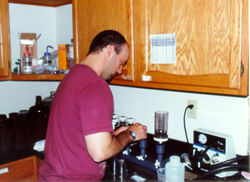|
Standardized water quality sampling conducted by staff of the Wisconsin
Department of Natural Resources Mississippi River Monitoring Field Station at La Crosse is comprised of the following:
- Biweekly or monthly sampling at 18 fixed sites in Pools 7-9,
including six tributaries to Pools 7-9, three backwater sites,
and several inflows and outflows of Pool 8.
- 150 randomly selected sites sampled during four intensive, two-week
episodes per year (i.e., winter, spring, summer, and fall, for
a total of 600 random sites per year). The random sites are stratified
by aquatic areas, which are loosely associated with habitat types.
Water quality parameters monitored during both types of sampling
include:
- In situ (on-site) measurements or observations of water velocity,
temperature, dissolved oxygen, conductivity, pH, Secchi disk transparency,
ice cover and thickness, snow depth, vegetation cover and density,
substrate type, wave height, and water depth.
- Laboratory analysis of turbidity, suspended and volatile solids,
chlorophyll a, phosphorus (total and soluble reactive), nitrogen
(total and dissolved inorganic), dissolved silica, chloride, and
metals (sodium, calcium, magnesium, potassium).
More specific information needed to interpret LTRMP water quality
data can be found at the following link: (water
quality data format file.) Water quality data can be downloaded
in text format at this site as well (water
quality data browser).
|
Kraig Hoff filters river water samples for chorophyll and
suspended solids after a day in the field. |

La Crosse Field Station water quality staff
log data continuously at certain backwater sites in winter
to assess limnological conditions under ice. This work led
to the discovery that in certain backwaters, under-ice conditions
are influenced by changes in main-channel water levels in
addition to known influences such as the amount of ice and
snow at the surface.

|
La Crosse Field Station Team Leader
Telephone: (608) 781-6360
Fax: (608) 783-6066
|
|
Water quality staff calibrate our multi-parameter datasondes
immediately before and after each fixed-site or random-site
monitoring day on the river. |
|
Shawn Giblin enters water quality data in the field on a laptop computer. |

Water quality staff collect samples all year.
This can be especially challenging in winter when wind-chill
in open areas can be extreme and ice can be treacherous.
 
|
|
A water quality staff member prepares to deploy a datasonde
unit in a quiet backwater full of lilypads. |
|













